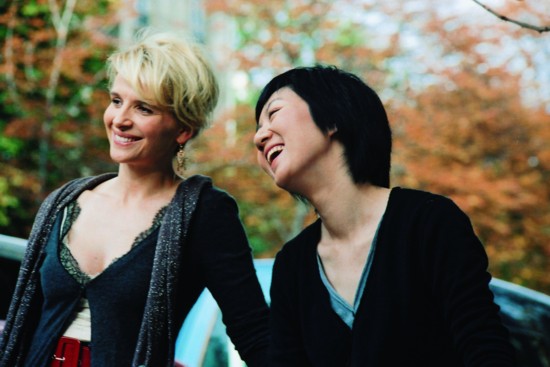|
Reviews of Recent Independent, Foreign, & Documentary Films in Theaters and DVD/Home Video
Directed by Hou Hsiao Hsien Written by Hou Hsiao Hsien and François Margolin Produced by Margolin & Kristina Larsen Director of Photography, Mark Lee Ping Bing Edited by Liao Ching Sung & Jean-Christopher Hym Released by IFC First Take French with English subtitles France. 113 min. Not Rated With Juliette Binoche, Simon Iteanu, Song Fang, Hippolyte Girardot & Louise Margolin Albert Lamorisse’s classic 1956 short The Red Balloon was the first film I saw as a child, and those with that shared experience will be predisposed to appreciate Hou Hsiao Hsien’s paean Flight of the Red Balloon. But the Taiwanese director only discovered it as an adult when he was commissioned by the Musée d’Orsay to make a film. Now others can fall under the spell of both films. Here we see Paris through the fresh eyes of Chinese film student Song (Song Fang, in a part written for her based on her own experiences), whose first entrée to the city was through Lamorisse’s film. While working at her new job as a babysitter, she also embarks on recreating the classic film with her own video camera. Like Chris Marker’s search through Paris for a feline’s image in The Case of the Grinning Cat, her camera seeks out the iconic red balloon through Paris, accompanied by her seven-year-old charge Simon (Simon Iteanu). The boy’s harried single mother, Suzanne (Juliette Binoche), much like Leslie Caron in Lili, passionately relates to puppets, carrying on her grandfather’s work in a musical marionette troupe. The links between Song and Suzanne grow when the mother enlists the student as a translator for a visiting Chinese puppet master. But Song is not only thrust into getting Simon home after school, with ritualistic stops at a bakery, a carousel, and a stroll in a park, she also gets entangled between Suzanne and her feuding neighbors and extended family. Hou meanders from incidents and details taken from Paris to the Moon, Adam Gopnik’s account of expatriate life in the city with a young child, and provided detailed character back stories for the actors to then improvise their dialogue. This looseness seems to free the dyed blonde Binoche to forego her mannerisms that, while charming in such recent films as Dan in Real Life, were getting repetitive. In one lovely scene, she very slowly unwinds listening to Simon recount his quotidian discoveries of the day. Hou, a bit didactically for his sponsor, makes the case for how Lamorisse’s film and a certain proprietary orb can lead a child to explore other visual and performing arts, even though Simon is a contemporary kid enraptured with video games. At the end, Simon’s class comes to the Musée to discuss Félix Vallotton’s 1899 painting Le ballon of a girl in a verdant landscape with, yes, a red balloon.
Hou’s tribute to a child in Paris provides the point of view that was barely touched on in two recent odes to the city which both featured Binoche,
the shorts collection Paris, Je T'Aime and Cédric Klapisch’s Paris (to be released later this year). Recently, the Lamorisse original
was revived in a beautiful new print at art houses around the U.S. While many grandparents were delighted to introduce young children to the film, I
was surprised by how many cinéastes shushed the kids’ spontaneous responses to the screen. Those stern deflators will not appreciate this easygoing
film.
Nora Lee Mandel
|

